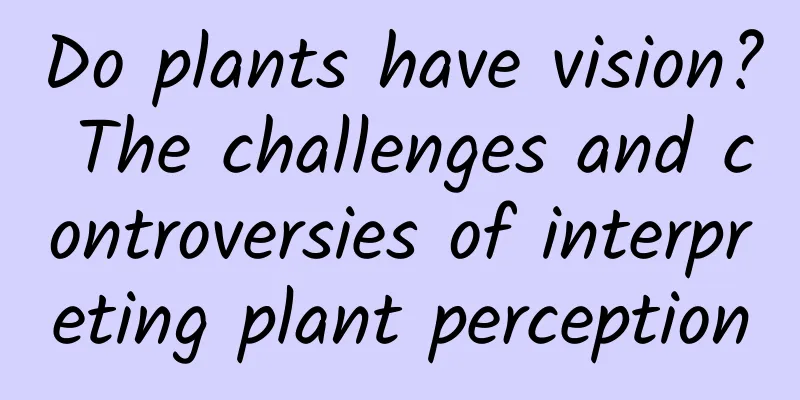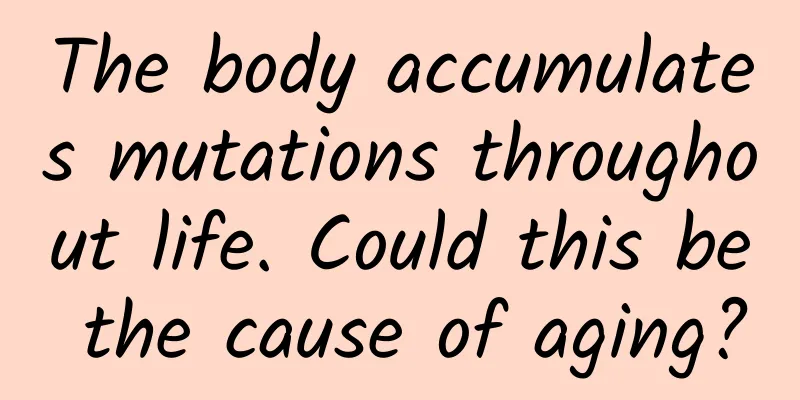Do plants have vision? The challenges and controversies of interpreting plant perception

|
Do plants have vision? Written by | Xiaoye In the tropical rain forest of Chile in South America, there lives a vine with extraordinary talent, called Boquila trifoliolata. They grow by climbing trees or other plants, and over time, their leaves will also change, "becoming like whoever they are." They will even imitate the leaves of other plants that are a certain distance away and not in contact with them, "if they like something, they will become that thing." Figure 1. Chagas' chameleon in nature | Source: 01 As early as the 19th century, naturalists discovered and described the magical function of the leaves of the chameleon. In the botanical world, this ability is called "mimicry." But scientists have never been able to explain the specific mechanism of how the chameleon does it. Ernesto Gianoli, a plant ecologist at the University of La Serena in Chile, has been studying the chameleon on and off for nearly a decade and is an important scholar in this field. In 2010, during a field survey, Gianoli accidentally discovered that the leaves of the chameleon vine could mimic the size, shape and color of more than 20 plant leaves. In 2014, he published a paper in the journal Current Biology [1], speculating that there are two possible mechanisms for the chameleon vine's leaf mimicry ability: The first is "transmission of volatile chemicals." Previous studies have shown that volatile organic compounds can induce specific responses in neighboring plants [2, 3], such as the production of secondary metabolites and changes in plant transcriptomes. Gianoli's team therefore hypothesized that certain volatile chemicals in the "prototype leaves" were transmitted through the air to the leaves of the chayote vine, affecting the latter's gene expression and thus producing phenotypic changes. The second hypothesis is "horizontal gene transfer between plants". That is, through airborne transmission media (microorganisms), parasitism between plants or natural grafting, the genes or epigenetic factors of the "prototype leaves" are transmitted to the chamaemelum nobile, affecting its trait expression. The second hypothesis is proposed because, although the chamaemelum nobile climbs the host tree trunk, the objects its leaves imitate are not limited to the host leaves, but also include the leaves of other plants closest to itself. However, Gianoli did not conduct subsequent experiments to verify his hypothesis [4]. In 2021, Gianoli's team made new progress in their research on the mimicry mechanism of the leaves of the chameleon. In November, they published an article in Scientific Reports[5], stating that using gene sequencing technology, they found similar microbial communities between the mimic leaves of the chameleon and the "prototype leaves", suggesting that microorganisms may be involved in mimicry behavior, but further experiments are still needed to verify this inference. At this time, a civil scientist stepped in. He proposed an incredibly simple reason for the mimicry of the chameleon: Maybe the chamaejasme can see what other leaves look like? 02 Jacob White from Utah, USA, has no scientific research background and has not received any scientific research training, but he is passionate about science and plants and loves to read popular science books and scientific research papers. Once, he read two papers that described the special photosensitive structures of two algae. The first article [6] believes that the phototactic behavior of the single-celled Chlamydomonas algae depends on the light receptors in its eyespot apparatus; the second article [7] introduces that the cells of the cyanobacteria Synechocystis genus play a role similar to spherical microlenses, that is, lenses, which allow cells to "see" light sources and move toward them. Both articles link algae with "eye-like" structures, and White began to associate: Is it possible that other plants have similar basic vision? At this time, a short review by plant physiologist František Baluška of the University of Bonn and plant neurobiologist Stefano Mancuso of the University of Florence proposed a view that coincided with White's [8]: plants may have eye-like structures that provide some form of vision. Figure 2. A review co-authored by Baluška and Mancuso proposed that plants have visual functions due to their unique simple eye structure. Source: After paying $40 to buy the full text and reading it, White learned more about the "plant vision" hypothesis. It turns out that as early as 1905, botanist Gottlieb Haberlandt had assumed that the epidermal cells in plant leaves could function as "simplified eyes", similar to the ocelli of insects. In the review, the author mentioned the contactless mimicry ability of the chameleon, speculating that it might be because the vine "saw" the "appearance" of its neighbors. This article further aroused White's curiosity, and he began to search the Internet for all research on "plant vision", especially on the chameleon. Unfortunately, professional scientists in the academic community seem to have little interest in this hypothesis, and no one has conducted rigorous experiments. The current mainstream view on the mimicry of Chamaecyparis is basically the transfer of chemical substances between plants and the microbial community proposed by Gianoli in the previous article. Although the visual hypothesis is shocking, it has not attracted much attention, let alone extensive research. Jacob White decided to do his own experiment. In order to prove that the chameleon has vision through experiments, White believes that the possibility of chemical transfer between plants must be ruled out first. After thinking for a long time, he had an idea: since the chameleon can imitate whatever leaves it sees, using artificial plants instead of real plants to contact the chameleon can not only "cheat" the chameleon's "eyes", but also avoid the problem of (bio)chemical transfer. He then bought a chaete vine and let it wrap around another artificial plant to observe its growth. Sure enough, the chaete vine would also try to imitate the shape of artificial leaves during its growth! White was very excited and immediately took a photo and sent it to Professor Baluška of the University of Bonn, one of the review authors. To his surprise, Baluška actually replied to him and suggested that he change the imitation object and find an artificial plant that is closer to the local plants in Chile. White did so and found that the chaete vine could still simulate the shape of new artificial leaves. After obtaining preliminary observation results, White hoped that Professor Baluška would take over and conduct more rigorous scientific experiments. He was afraid that he was just an outsider without any scientific research qualifications and would be criticized by professionals as a "folk scientist". He bought four more chamaecyparis sempervirens and planned to find a way to get them to Germany to give to Professor Baluška. Unexpectedly, the professor encouraged him to continue independent experiments and gave him guidance. White started to design a more complicated experiment. However, there was trouble with the experimental setup at the beginning: since it was a scientific study, an experimental group and a control group had to be arranged. Unfortunately, due to the limited space at White's home, he could only let the chamaeleon vine serve as the control group (compared with its original self). The specific experimental design is shown in Figure 3: four pots of chamaeleon vine were placed side by side by the window, under two horizontal frames. At the beginning, the vines grew independently without clinging to any artificial plants. When they grew beyond the first horizontal frame, the vines were allowed to wrap around the artificial plants and continue to grow. In this way, with the first horizontal frame as the boundary, White could compare the conditions of the chamaeleon leaves above and below the horizontal frame. Figure 3. Jacob White’s experimental design [9] Figure 4. Four chaenomeles used in experiments at Jacob White’s home. 丨Source: The four chamaejasmines showed amazing mimicry. In the first year, the leaves of the vines that touched the artificial plants were obviously different from those under the horizontal frame, but the imitation effect was not very good. In the second year, the vines sprouted more buds, and the newly grown leaves became more like artificial leaves, but smaller. As time passed, the new leaves of the chamaejasmine grew more and more like artificial leaves. White recorded the whole process in the form of photos and videos and sent them all to Baluška. The professor replied that he might as well publish a paper! So White wrote an article about the whole research process and submitted it to the journal Plant Signaling and Behavior - the editor-in-chief happened to be František Baluška. Baluška sent the first draft of the article to nine peer reviewers, seven of whom gave feedback. The comments were mixed, with some immediately refuting and others praising and asking some unconventional questions. But everyone agreed that the paper needed to provide more solid data. So Baluška suggested that Felipe Yamashita, a graduate student in his laboratory, assist White in the morphological analysis. Yamashita had not studied the chameleon in the past, but his main topic was plant intelligence, and plant vision happened to fall into this range. So White sent the leaves of the chameleon to Yamashita for measurement and inspection. Figure 5. Unmimicked leaves of Chaenomeles sinensis (A) and mimicked leaves (B). The red arrows indicate the unclosed fine veins. [9] Morphological analysis showed that the leaves above the crossbar that appeared to be mimicked were indeed different from the native leaves below, and there were also significant differences between the youngest leaves near the top of the vine and the oldest leaves at the bottom. Specifically, the veinlets of the top leaves tended to be connected to other veins, while one end of the veins of the bottom leaves was often open. This is a manifestation of differences in hormone levels: hormones are involved in the formation of the leaf vein map. As the vine grows, the open ends of the veinlets decrease, indicating that different levels of hormones exist in the mimic leaves and the leaves without any mimicry. In the end, White and Yamashita revised the paper together, and it was finally accepted by the journal and published in September 2021 [9]. Figure 6. White and Yamashita’s paper[9] This paper, jointly published by citizen scientist White and botany graduate student Yamashita, caused an unexpected sensation. Faculty Opinions (formerly F1000Prime), an important international biomedical academic paper evaluation organization, selected it as a recommended paper [10], with the category of "new finding" and the rating of "exceptional" (the highest rating). Experts praised it for "helping to promote the vigorous development of research on plant photosensitivity." In addition, a popular plant-themed account on Tiktok posted a video introducing tropical plants [11], which cited this paper and received 2.3 million views and more than 600,000 likes. There are praises and criticisms. After carefully reading this paper, researchers in the same field questioned both the content itself and the publication process. Ernesto Gianoli, a leading researcher on the chameleon vine who did not participate in the peer review of the paper, was the first to fire the first shot. He pointed out that there was a very obvious flaw in the experimental design: confounding factors were not excluded. Gianoli believes that light and leaf age are two important confounding factors, but the experimental design did not exclude these two variables. The leaves under the horizontal frame may have been in the shade all the time. In order to obtain as much sunlight energy as possible, they will strive to grow larger. When the vines climb upward and enter a space with more abundant light, the leaves will grow smaller to reduce water loss. The smaller the leaves, the more rounded the shape will be, the fewer rugged outlines there will be, and the more they look like fake leaves. If the interference factor of light is not excluded first, it is impossible to determine whether the change in leaf shape is the result of mimicry or just a reduction in size. Similarly, leaves at different growth stages naturally show different morphologies, so the developmental age of the leaves may also affect the final conclusion of their mimicry mechanism. Secondly, the data analysis method used in the paper was also accused of being used improperly. John Pannell, a plant evolutionary biologist at the University of Lausanne in Switzerland, pointed out that the study measured different leaf types of the same plant, indicating that the leaves were not independent of each other, and the T test and one-way ANOVA used in the paper are only applicable when the data are independent and do not interfere with each other. If the statistical method is used incorrectly, the p value obtained will be meaningless. The third question is about "confirmatory bias", also known as "verification bias". Simply put, scientists love their hypotheses too much and hope that their theories are correct, so in the verification process, they selectively use the direction that is conducive to "hypothesis is true" to design experiments, collect evidence, and interpret results. White and Yamashita's paper has this tendency - there is no in-depth discussion of the rationality of the plant vision mechanism, no exclusion of confounding factors in the experiment, and when analyzing the experimental results, the leaves are simply divided into "mimicry leaves" and "non-mimicry leaves"... This shows that the author did not maintain an objective and critical attitude, but just wanted to determine that the visual hypothesis is correct. However, the above problems cannot all be blamed on the authors. Scholars were surprised that professional editors and peer reviewers did not discover them during the review process... The editors and authors did not make a clear response to these questions. The last common question is the lack of a conflict of interest statement: František Baluška, the editor-in-chief of Plant Signaling and Behavior, is also the mentor of the paper author Yamashita. According to the paper writing standards, the author should state what role Baluška played in the paper publishing process. Only by clarifying the conflict of interest between the author and the editor can readers judge how such a conflict of interest will affect the interpretation of the results during the reading process. Adam Marcus, editor-in-chief of the famous medical website Medscape and co-founder of the Retraction Watch website, also agreed that conflicts of interest should be stated in such cases. Moreover, Baluška should have taken the initiative to avoid suspicion during the publication process and handed the paper over to other editors-in-chief. The current practice may have a negative impact on the journal as a whole. In response to this question, Baluška gave only a brief response: "To eliminate all possible problems, I have asked for the opinions of nine peer reviewers." After being dormant for more than a century, the "plant vision" hypothesis was revived by Baluška's team. Baluška himself has always believed that plants have some type of vision. Before the publication of the 2016 review, he led his team to conduct experiments using the roots of Arabidopsis thaliana as the research object. He discovered the photosensitivity mechanism based on plant-specific photoreceptors and proposed that "root apex ocelli" plays a similar function to lens cells [12]. He further speculated that there are information conversion areas in the roots, similar to the structure of the brain, which interpret the light and dark information of the plant's environment through a signal transduction pathway network based on photoreceptors and guide the growth direction of the roots [13, 14]. Therefore, it is not difficult to understand that Baluška, who believes that plant roots may have vision, would support White to conduct experiments and publish papers, because this would be another important evidence to prove the "plant vision" hypothesis. Baluška and Yamashita's latest collaborative paper once again emphasized the "plant vision" theory. Based on their previous related research and White's research, they proposed that plant eyes evolved from algae eyes, are part of the complex sensory system of plants, and guide the cognitive behavior of plants [15]. Gianoli commented on Baluška's review of "plant vision" in 2016. First, in terms of the mechanism behind the mimicry of the chamaecyparis, Gianoli prefers his own explanation: the conduction of volatile chemicals and horizontal gene transfer within ecological time scales - because leaf mimicry is fundamentally different from plant phototropism (such as the unicellular Chlamydomonas and Synechocystis) and leaf orientation, and therefore has a weaker correlation with plant vision [16]. However, Gianoli did not completely deny the hypothesis that "plants can see", but so far, no convincing evidence has been provided. In response to Gianoli's question, Baluška explained that leaf mimicry is to change the spatial arrangement of its own structure. The prerequisite for the change is to have a concept of the shape or size of the imitated object. One must first "see" the other's "appearance" through some type of vision before being able to imitate it. Chemical substances cannot play a role in this regard. Both sides have always insisted on their own opinions. White and Yamashita actively defended their research results, and Yamashita said that they are already planning the next step of research. They want to add chameleon vines, improve the control group settings, and replicate White's experimental results; they will also cooperate with Mancuso's team at the University of Florence to conduct investigations from the perspective of plant electrophysiology to explore whether electrical activity will suddenly occur in the vines when other plants appear near the chameleon vines. Gianoli hopes to conduct further field investigations to see if the mechanism of plant mimicry ability can be explained. Whatever the answer, if the researchers can eventually solve the mystery, the answer may become an important new foundation for biology. Although Gianoli was the first to question “folk science research”, he gave a high evaluation of the research process of Jacob White, a folk scientist: “I am so excited that people can grow chafingers in their own homes.” In fact, both Gianoli and Baluška have tried to cultivate chafingers in the laboratory, but for some reason, the chafingers did not grow well, so they could not continue their in-depth research. Gianoli said: “As scientists, we need such bold methods and we need to think outside the box. But at the same time, we should not forget the norms and clarify what counts as evidence and what does not count as evidence.”[17] “I believe plant science is going to undergo a huge transformation,” White said. “Every day new papers are published that show how amazing plants are, and I’m proud to be a part of it.”[17] References [1] https://www.sciencedirect.com/science/article/pii/S0960982214002693 [2] https://www.sciencedirect.com/science/article/abs/pii/S0031942208000800 [3] https://www.sciencedirect.com/science/article/abs/pii/S0169534709003000 [4] https://www.cell.com/current-biology/fulltext/S0960-9822(14)00388-1?_returnURL=https%3A%2F%2Flinkinghub.elsevier.com%2Fretrieve%2Fpii%2FS0960982214003881%3Fshowall%3Dtrue [5] https://www.nature.com/articles/s41598-021-02229-8 [6] https://www.pnas.org/doi/10.1073/pnas.1525538113 [7] https://elifesciences.org/articles/12620 [8] https://www.cell.com/trends/plant-science/fulltext/S1360-1385(16)30093-0 [9] https://www.tandfonline.com/doi/full/10.1080/15592324.2021.1977530 [11] https://facultyopinions.com/article/740848575 [11] https://www.tiktok.com/@tallikesplants/video/7154776470370536750 [12] https://www.frontiersin.org/articles/10.3389/fpls.2015.00775/full [13] https://linkinghub.elsevier.com/retrieve/pii/S1674205214603300 [14] https://academic.oup.com/plcell/article/24/2/551/6097134 [15] https://www.mdpi.com/2223-7747/12/1/61 [16] https://www.cell.com/trends/plant-science/fulltext/S1360-1385(16)30171-6?_returnURL=https%3A%2F%2Flinkinghub.elsevier.com%2Fretrieve%2Fpii%2FS1360138516301716%3Fshowall%3Dtrue [17] https://www.the-scientist.com/news-opinion/can-plants-see-in-the-wake-of-a-controversial-study-the-answer-is-still-unclear-70796 This article is supported by the Science Popularization China Starry Sky Project Produced by: China Association for Science and Technology Department of Science Popularization Producer: China Science and Technology Press Co., Ltd., Beijing Zhongke Xinghe Culture Media Co., Ltd. |
<<: Shocking! 4 seemingly healthy vegetables are actually "gout bombs"! See if you are eating them?
>>: Is it my hair that I'm losing? No, it's probably diamonds!
Recommend
There are “tricks” to making popular products, here are the creative secrets for Internet finance advertising!
In the attention economy, high-quality creativity...
Ex situ conservation protects our elk from getting lost
Produced by: Science Popularization China Produce...
Where is the future of new media operations?
A few months ago, a friend who works in new media...
The trend of Douyin e-commerce bringing goods to monetize!
The short video industry will reach 1 billion dai...
These 24 practical widgets will turn your iPhone into an efficient tool in seconds
In fact, since iOS 8, Apple has integrated widget...
More than 10 million doses of COVID-19 vaccine have been administered! Here's how to find the nearest vaccination site
Since the implementation of the COVID-19 vaccinat...
Potatoes can cause poisoning if kept in the refrigerator...Do vegetables really need to be kept in the refrigerator?
Source: A Brief History This article has been aut...
The best ways to exercise after 40 are revealed. It turns out that these are the types! Many people exercise incorrectly!
What kind of sports should you choose after you t...
How to operate Zhihu circle? A complete review of the increase of 2000+ followers in one week!
Many things are about money, but also not about m...
Summary of the main algorithms of the recommendation system and examples of Youtube's deep learning recommendation algorithm
Collaborative filtering Collaborative filtering (...
A lifeline for the video industry caught in the IP vortex?
April 10 (Reporter Zhang Zhichang) Under the guid...
Android 9.0 is now available! Xiaomi, OnePlus, and OV are the first to release it
Google announced today that Android P (not surpri...
How to create a popular WeChat mini-program mall?
Nowadays, many brands have become popular with th...
Six pictures! Help you understand the "high-frequency synonyms" in this round of epidemic prevention and control
Venue code and health code, antigen test and nucl...
Wang Hongjun: New energy buses face six development trends
From June 5th to 6th, the 2018 (9th) Global Autom...









